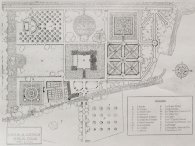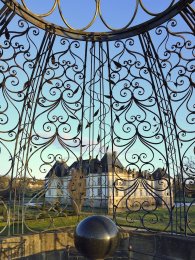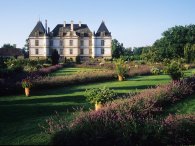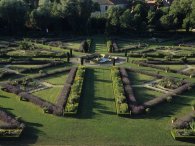‘Pleasure gardens’
‘It is the object of all great gardens to find that harmony between the intellectual world of reading rooms and the ever living world of flowers and trees’ (Michel Baridon about Cormatin).
‘It is the object of all great gardens to find that harmony between the intellectual world of reading rooms and the ever living world of flowers and trees’ (Michel Baridon about Cormatin).

Created circa 1620 and revamped in the "English" style about 1785, the gardens had disappeared by 1815, when the earth was used to fill the moat. Some beautiful trees survived, a three hundred year old oak, seven swamp cypresses and the 130 lime trees in the Lamartine avenue beside the river.
In 1988-89, the re-excavation of the moat allowed the reconstruction of the garden platforms. Over 13000m3 of earth having been moved, flowerbeds, groves and maze were replanted from 1990 to 1993.
The aim was to recover both the spirit and the form of a baroque garden, at the same time playful, sensual and philosophical.


‘First of all is the pleasure of discovery here and this pleasure is infinite. You can vary the views by doing a turn round the chateau, walk the promenades to look down on the large central parterre, wander over the grassy paths and identify plants and shrubs that parade for us, follow the shimmering reflections the length of the quiet mirrors of water, discover the old oaks, the avenue of lime trees, the outdoor theatre, cast an admiring eye over the play of colors, which enliven the vegetable garden ...’ Michel Baridon.

The ‘Dream of Poliphile’ (1499) and its five magical gardens, where the hero ventures in search of Wisdom, remained through the Baroque age the standard text for the creators of gardens. The plan, proportions, colors, plants, statues and inscriptions, all must contribute to make the garden the canvass of a meditation on the place of man in God’s creation.
The parterre garden, at the foot of the apartments of honor, is the earthly paradise with Adam and Eve, the apple of knowledge, the fountain of life, etc..
The labyrinth symbolizes the trials of life after the original sin and the aviary-gazebo is the heavenly reward offered to the elect ...
The wanderer is encouraged to reflect by a quotation from Nietzsche, engraved in gold letters at the entrance of the garden: ‘It is us that must translate both the stone and the plant so that we can walk in ourselves’.

